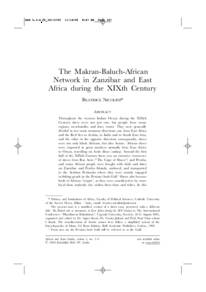وثيقة
The Makran-Baluch-African network in Zanzibar and East Africa during the XIXTH century.
المعرف
DOI: 10.1163/ej.9789004162914.i-196
الناشر
Koninklijke Brill.
ميلادي
2008-07
اللغة
الأنجليزية
الموضوع
الملخص الإنجليزي
Throughout the western Indian Ocean during the XIXth Century there were not just one, but people from many regions, merchandise and slave routes. They were generally divided in two main monsoon directions: one from East Africa and the Red Sea to Arabia, to India and to South East Asia, and the other in the opposite direction; consequently, slaves were not only black Africans, but also Asians.1 African slaves were imported in great numbers annually from East Africa to Oman, travelling on Arab dhows (sanbuq). Around the first half of the XIXth Century there was an extensive commerce of slaves from Ras Assir ("The Cape of Slaves") and Pemba, and many African people were bought with cloth and dates on Zanzibar and Pemba Islands, enslaved, and transported to the Arabian Peninsula where they were mainly engaged in fishing pearls in the Persian/ Arab Gulf.2 Slaves also became lords of African "reigns", as they were considered to be more loyal than anybody else within their clans and tribes. In this regard, Omanis used to recruit mercenary troops also from the Baluch tribes, who developed a long-lived military tradition, representing a real element of power within Omani areas of influence in East sub-Saharan Africa. This article examines the role played by the Makrani-Baluch tribes during the XIXth Century's sub-Saharan East African apogee with the Omanis, and their influence on the social, political and economic level giving special attention to slavery.
المجموعة
ردمك
978-900416291-4
URL المصدر
قالب العنصر
مقالات الدوريات

